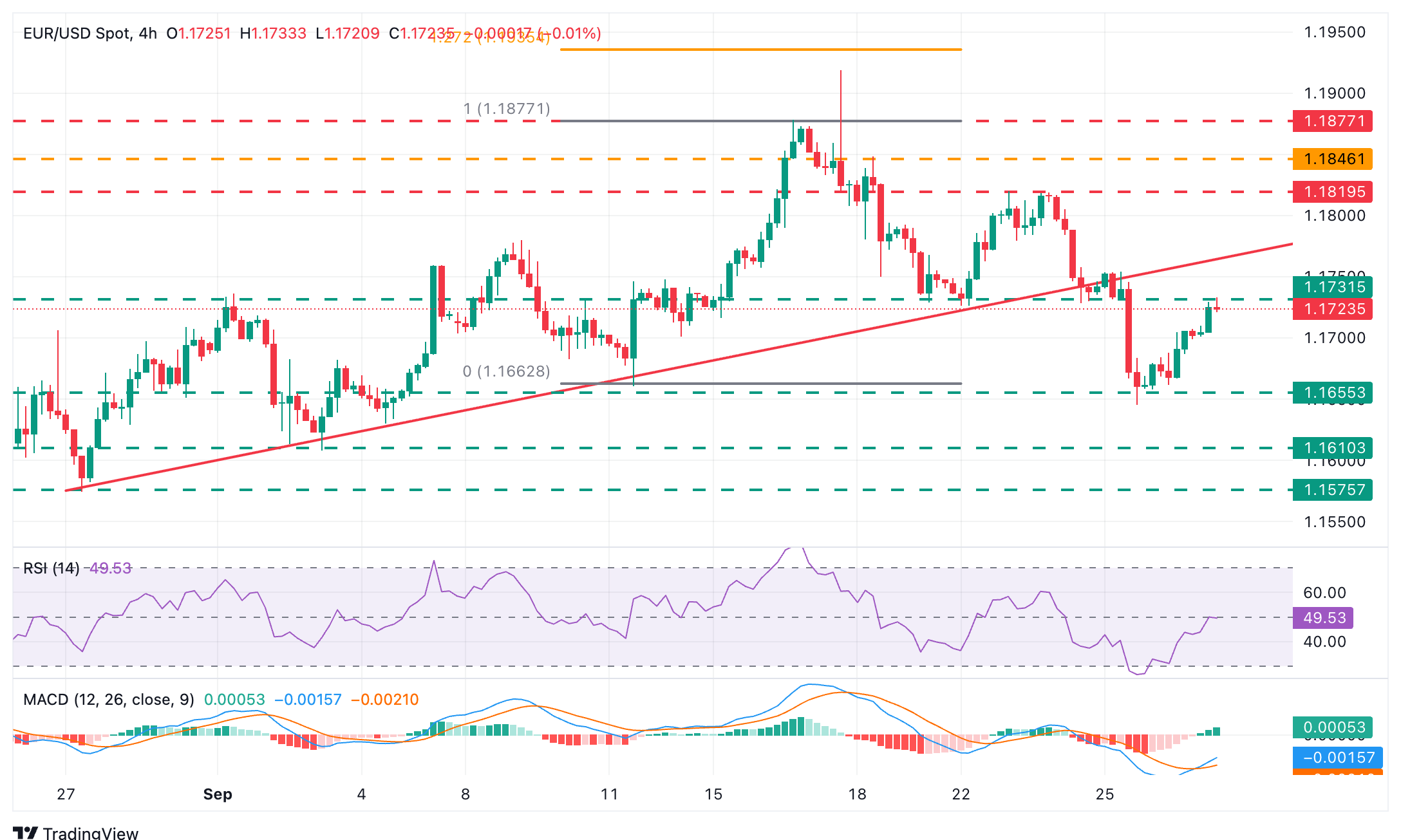Created
: 2025.09.29














![]() 2025.09.29 16:45
2025.09.29 16:45
EUR/USD opened the week in a moderately bid tone, extending its recovery to 1.1725 at the time of writing on Monday, after bouncing from 1.1645 lows last week. Investors' concerns about a highly likely US government shutdown this week and hopes of back-to-back Federal Reserve (Fed) interest rate cuts have sent US Treasury yields and the US Dollar (USD) lower across the board.
The main focus on Monday is on US President Donald Trump, who will hold a meeting with Republican and Democratic representatives in the last attempt to avoid the closure of the government on Wednesday, which is the first day of the 2026 fiscal year.
Chances of a last-minute agreement, however, seem remote, as the positions of both parties are far apart. The consequences of a shutdown tend to be bearable, unless it is a protracted one, but in this case, it might delay the release of the key Nonfarm Payrolls report due on Friday, which could seriously complicate the Fed's rate-setting activity if the data is not released before the central bank's meeting on October 28.
In the macroeconomic domain, the Eurozone's Consumer Confidence data and a slew of European Central Bank (ECB) speakers will provide some fundamental context for the Euro, while in the American session, a slew of Fed officials are likely to offer further clues about the bank's near-term monetary policy.
The table below shows the percentage change of Euro (EUR) against listed major currencies today. Euro was the strongest against the US Dollar.
| USD | EUR | GBP | JPY | CAD | AUD | NZD | CHF | |
|---|---|---|---|---|---|---|---|---|
| USD | -0.19% | -0.34% | -0.46% | -0.08% | -0.31% | -0.04% | -0.18% | |
| EUR | 0.19% | -0.15% | -0.44% | 0.10% | -0.12% | 0.14% | -0.00% | |
| GBP | 0.34% | 0.15% | -0.16% | 0.25% | -0.03% | 0.30% | 0.15% | |
| JPY | 0.46% | 0.44% | 0.16% | 0.42% | 0.19% | 0.30% | 0.33% | |
| CAD | 0.08% | -0.10% | -0.25% | -0.42% | -0.20% | 0.04% | -0.10% | |
| AUD | 0.31% | 0.12% | 0.03% | -0.19% | 0.20% | 0.27% | 0.12% | |
| NZD | 0.04% | -0.14% | -0.30% | -0.30% | -0.04% | -0.27% | 0.00% | |
| CHF | 0.18% | 0.00% | -0.15% | -0.33% | 0.10% | -0.12% | -0.00% |
The heat map shows percentage changes of major currencies against each other. The base currency is picked from the left column, while the quote currency is picked from the top row. For example, if you pick the Euro from the left column and move along the horizontal line to the US Dollar, the percentage change displayed in the box will represent EUR (base)/USD (quote).

EUR/USD is moving up on Monday, yet with technical indicators on the 4-hour chart mixed. The Moving Average Convergence Divergence (MACD) shows a bullish crossover, but the Relative Strength Index (RSI) is struggling to return above the key 50 level, which suggests that the upward trend is frail. The pair broke below an ascending trendline last week, highlighting a potential trend shift and might be on a corrective recovery, ahead of further depreciation.
The September 19 and 20 lows, around 1.1730, are now acting as resistance, ahead of the reverse trendline, now at 1.1765. The pair should return above those levels to break the immediate bearish structure and shift the focus back to the September 23 and 24 highs, at 1.1820.
To the downside, support is located in the 1.1645-1-1455 area, which held the pair last week and also on September 11. Further down, the September 2 and 3 lows, near 1.1610 and the August 27 low, at 1.1575, would be the next targets.
The Euro is the currency for the 19 European Union countries that belong to the Eurozone. It is the second most heavily traded currency in the world behind the US Dollar. In 2022, it accounted for 31% of all foreign exchange transactions, with an average daily turnover of over $2.2 trillion a day. EUR/USD is the most heavily traded currency pair in the world, accounting for an estimated 30% off all transactions, followed by EUR/JPY (4%), EUR/GBP (3%) and EUR/AUD (2%).
The European Central Bank (ECB) in Frankfurt, Germany, is the reserve bank for the Eurozone. The ECB sets interest rates and manages monetary policy. The ECB's primary mandate is to maintain price stability, which means either controlling inflation or stimulating growth. Its primary tool is the raising or lowering of interest rates. Relatively high interest rates - or the expectation of higher rates - will usually benefit the Euro and vice versa. The ECB Governing Council makes monetary policy decisions at meetings held eight times a year. Decisions are made by heads of the Eurozone national banks and six permanent members, including the President of the ECB, Christine Lagarde.
Eurozone inflation data, measured by the Harmonized Index of Consumer Prices (HICP), is an important econometric for the Euro. If inflation rises more than expected, especially if above the ECB's 2% target, it obliges the ECB to raise interest rates to bring it back under control. Relatively high interest rates compared to its counterparts will usually benefit the Euro, as it makes the region more attractive as a place for global investors to park their money.
Data releases gauge the health of the economy and can impact on the Euro. Indicators such as GDP, Manufacturing and Services PMIs, employment, and consumer sentiment surveys can all influence the direction of the single currency. A strong economy is good for the Euro. Not only does it attract more foreign investment but it may encourage the ECB to put up interest rates, which will directly strengthen the Euro. Otherwise, if economic data is weak, the Euro is likely to fall. Economic data for the four largest economies in the euro area (Germany, France, Italy and Spain) are especially significant, as they account for 75% of the Eurozone's economy.
Another significant data release for the Euro is the Trade Balance. This indicator measures the difference between what a country earns from its exports and what it spends on imports over a given period. If a country produces highly sought after exports then its currency will gain in value purely from the extra demand created from foreign buyers seeking to purchase these goods. Therefore, a positive net Trade Balance strengthens a currency and vice versa for a negative balance.
![]()
Created
: 2025.09.29
![]()
Last updated
: 2025.09.29

FXStreet is a forex information website, delivering market analysis and news articles 24/7.
It features a number of articles contributed by well-known analysts, in addition to the ones by its editorial team.
Founded in 2000 by Francesc Riverola, a Spanish economist, it has grown to become a world-renowned information website.
We hope you find this article useful. Any comments or suggestions will be greatly appreciated.
We are also looking for writers with extensive experience in forex and crypto to join us.
please contact us at [email protected].
Disclaimer:
All information and content provided on this website is provided for informational purposes only and is not intended to solicit any investment. Although all efforts are made in order to ensure that the information is correct, no guarantee is provided for the accuracy of any content on this website. Any decision made shall be the responsibility of the investor and Myforex does not take any responsibility whatsoever regarding the use of any information provided herein.
The content provided on this website belongs to Myforex and, where stated, the relevant licensors. All rights are reserved by Myforex and the relevant licensors, and no content of this website, whether in full or in part, shall be copied or displayed elsewhere without the explicit written permission of the relevant copyright holder. If you wish to use any part of the content provided on this website, please ensure that you contact Myforex.
Myforex uses cookies to improve the convenience and functionality of this website. This website may include cookies not only by us but also by third parties (advertisers, log analysts, etc.) for the purpose of tracking the activities of users. Cookie policy